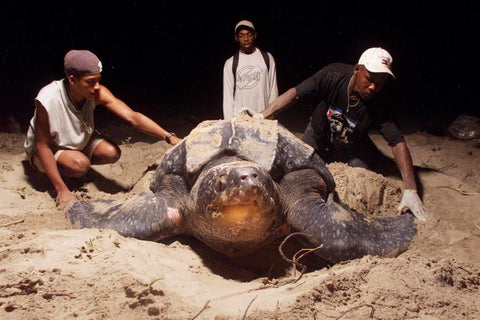About Sea Turtles

About Sea Turtles
There are seven species of sea turtles, which are marine reptiles that need to breathe air to survive. Six of the seven species are found in US waters, and the flatback turtle is only found in the Western Indo-Pacific. Most of their lives are spent at sea, with some species diving to depths of 3000 feet (900 meters). They return to the shore to lay eggs, often making long journeys to go to their birthplace beaches year after year.
Their wide-reaching movement and the small amount of time they spend on land means that it is hard to measure just how many sea turtles remain, or how many there used to be. (One estimate is that millions of green sea turtles were in the Caribbean at the time of Christopher Columbus.) Now ALL SIX of the species found in US waters are listed as endangered under the Endangered Species Act, and those six are also found on the IUCN Red List where their listings range from Vulnerable to Critically Endangered. They have many human-induced threats including entanglement in fishing gear, marine debris, coastal habitat destruction, poaching of adults and eggs, and climate change.
Below, 12 interesting facts about sea turtles, aka, the coolest surfers in the sea.
- They’ve been around for a very, very long time.The oldest known sea turtle fossils date back about 150 million years, making them some of the oldest creatures on Earth. Just for some context, dinosaurs became extinct 65 million years ago.
- They really love to travel. Leatherback sea turtles can travel more than 10,000 miles every year.
- For sea turtles, home is where the heart is. When it's time to lay their eggs, female sea turtles return to the same nesting grounds where they were born.
- They can hold their breath for a very (very, very) long time. Green sea turtles can stay underwater for up to five hours, but their feeding dives usually only last five minutes or less.
- They can grow to be suuuuuper heavy. Leatherback sea turtles can weigh up to 2,000 pounds and 7 feet long.
- Their eggs look amazingly like pingpong balls. But they're not, so don’t try to play with them! Females lay up to 150 eggs every two to three years. A couple months later, tiny turtles emerge.

- And for the new hatchlings, it really is survival of the fittest. It is estimated that only one hatchling in a thousand will make it to adulthood. Whether it's the treacherous journey from nest to ocean or the predatory dangers of the open sea, it’s a cruel, cruel world out there for these youngsters.
- Male sea turtles spend their entire lives at sea. Since they don’t have to return to land to lay eggs, males almost never leave the ocean. This can make it difficult to keep track of population numbers.
- Sometimes they cry, but not because they’re sad. Sea turtles have glands that help to empty excess salt from their eyes, making it appear as though they’re crying, but not to worry, they're just doing some spring cleaning.
- Their gender depends on how hot or cold their environment was while they were in their eggs. During incubation, sex is determined by the temperature of the surrounding environment. Warm temperatures tend to produce more female hatchlings, whereas cooler temps result in more males. Climate change has an effect here.

- They’re in deep trouble and it's our fault. There are seven species of sea turtles, six of which are either threatened or endangered. Humans pose the biggest threat to a sea turtle's survival, which contributes to problems such as entanglement, habitat loss and consumption of their eggs and meat.
- They’re totally adorable. But you already knew that!


